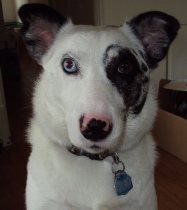
Copyright © 2013 CanineCancer.org.au All rights reserved.
A pleural port is used to drain the fluid off the pleural cavity -
Treatments
When your dog is diagnosed with cancer, your oncologist will provide your dog with a treatment plan. It will be tailored to suit your dog based on the type of cancer, and the grading and staging. Some of the treatments that could be offered are outlined on this page. All information provided on this page has been checked for accuracy by Perth Veterinary Specialists.
Radiation
There are two radiation therapy units in the Southern Hemisphere for animals. The first unit is an orthovoltage machine which was installed at Southpaws Specialty Surgery for Animals in Melbourne, Australia in 2006. Orthovoltage is older technology. While it is very reliable, it is not capable of delivering large doses of radiation to structures deeper than a few centimetres below the surface of the skin.
The second unit was installed at the Brisbane Veterinary Specialist Centre in 2007. This is a linear accelerator which is much more advanced technology. It has a much higher energy, and therefore is capable of delivering large doses of radiation to deep structures while sparing the overlying skin. Because the absorption of this type of radiation is very predictable, computer modelling can be used to very accurately deliver radiation to tumours while sparing normal structures.
Radiation therapy equipment at both centres is the same as is used to treat various human cancers that cannot be treated by surgery or chemotherapy. Radiation units deliver a high energy beam of radiation directly to the tumour. The beam can either kill the cancer cells or make them unable to multiply by damaging the DNA molecule in the cell nucleus. Radiation is unable to identify the difference between normal cells and cancer cells and it therefore destroys the normal cells as well. Normal cells however can regenerate and repair themselves, whilst the cancerous cells that have been damaged lose their repair mechanism and die off from the treatment.
Radiation is used in a way that can kill off the cancerous cells, but allow the normal cells time to repair themselves. It is normally given in small increments over two to four weeks depending on the type of cancer being treated. If the intent is curative it would normally be given on a daily basis, however pallative radiation may be done once a week for four to six weeks. The treatment itself only takes a few minutes but your pet must remain perfectly still, so a brief anaesthetic is given. The anaesthetic is eliminated rapidly allowing you to take your pet home with no side effects normally attributed to anaesthetics.
For more detailed information on radiation.
Surgery
Surgery is often the best choice of treatment for tumours. It is very important when a tumour is removed that it is done correctly and enough surrounding tissue which is free of cancer cells is also removed. If the surrounding tissue has cancer cells in it, the margins are considered dirty and further treatment will be needed. If pathology testing after removal indicates that all the tumour and the tissue surrounding the tumour has no sign of cancer cells, then further treatment will only be necessary if likely to spread elsewhere (i.e. a malignant tumour). Due to location, or age and health of the dog, some tumours may not be able to be surgically removed.
For more detailed information on surgery
Chemotherapy
Chemotherapy simply means using drugs to treat disease. We tend to use the word to imply Cancer Chemotherapy, but it still means ANY drug used to fight ANY cancer. Reserch tells us WHICH drug is most useful for EACH patient based on their cancer type, their breed, and any other disease they may have. Each chemotherapy drug is different and carries different risks and a specialist oncologist will be very familiar with each of the drugs, how they work, their possible benefits and their possible risks.
Some chemotherapy will have to be given intravenously, others injected into the tumour and some given orally. How often your dog will have chemotherapy. depends on the cancer and the treatment options given to you by your oncologist.
Common drugs include Lomustine, Carboplatin, Chlorambucil, Vincristine, Doxorubicin, Vinblastine, Masitinib, Toceranib, Cyclophosphamide, Actinomycin D, Epirubicin and Mitoxantrone. The drugs come from many sources. For example, Cyclophosphamide is a synthetic chemical, vincristine is a plant extract and doxorubicin is made by bacteria.
For more detailed information on chemotherapy.
Chemo At Home here
Dr Sandra Nguyen MVSc Dipl ACVIM (Oncology) video on chemotherapy
See how chemotherapy is given to dogs video from Dr Sue Cancer Vet
See Bear getting his doxorubicin chemotherapy video from Dr Sue Cancer Vet
Cryosurgery
Cryosurgery is the application of extreme cold to destroy diseased tissue. It does not involve any cutting to the skin, just the application of intense cold. This type of treatment temporarily numbs the surrounding sensory nerves and reduces pain and discomfort. It is often used in areas where conventional surgery can't be done. Areas such as the mouth, anus or when a dog is elderly and is at risk from anaesthetic.
The treatment is carried out under anaesthetic, either local with a sedative or by general anaesthetic. Once freezing has been done, the tissue slowly dies and falls away. In some areas such as the mouth and anus it may liquify and look green and usually gentle bathing is all that is needed to remove the dead tissue.
In many cases, cryosurgery can be curative depending on the tumour and its location. In advanced or more serious cases, more than one session of cryosurgery might be required.
Electrochemotherapy
Electrochemotherapy is the delivery of electric pulses on solid tumours. The electric pulses are delivered after the intralesional injection of chemotherapy to the tumour.
Intralesional Chemotherapy
Intralesional Chemotherapy is the treatment of a tumour with a direct injection of chemotherapy to the tumour The advantage of this technique is that very high concentrations of drug can be placed into the tumour, with very little diffusing out into the patient. Chemotherapy side effects, therefore do not occur.
Metronomic Therapy
Metronomic Therapy is a frequent (daily to every second day), at home treatment which inhibits new blood supply to the tumour and therefore inhibits growth. Low doses of chemotherapy for long periods of time can starve the blood supply to the tumour. The tumour is then deprived of the necessary oxygen and nutrients needed if it is to grow. Due to the low doses of chemotherapy used. there is less likelihood of the side effects that can occur with the usage of standard chemotherapy. This approach has proven very successful for low to moderate grade soft tissue sarcomas in dogs, with excellent results.
For more detailed information on metronomic therapy.



Pet Insurance
Have you got pet insurance for your dog or cat?
Vet fees can be expensive. For the small amount pet insurance costs each week, your dog or cat will be able to have the best treatments that are available if they get sick.
For a list of pet insurance comparisons, click the link below.





Amputation
When owners contemplate the loss of a loved pet’s limb, it is understandably very upsetting. The reality is, however, that both cats and dogs, including large and giant breeds, generally cope extremely well with the amputation of a fore-
There are some instances where an aggressive resection can be performed without resorting to an amputation. There are now specialist surgical oncologists present in most states in Australia that can advise you on what options are available to you and a reasonable expectation of what can be achieved with these different options. They should be able to give you a good indication if an amputation is appropriate in your pet. Amputation remains a very important tool in the arsenal against cancer.
Article supplied by:
Ramesh K Sivacolundhu
BSc BVMS MVS FANZCVS (Small Animal Surgery)



Cyberknife
CyberKnife is a form of radiation treatment, otherwise known as radiosurgery. It is used in place of surgery, typically for inoperable tumors. The most common tumors treated are brain tumors and nasal tumors One of the main benefits of CyberKnife compared to conventional radiation is its precision, which means less damage to the surrounding healthy tissue.
CyberKnife is not a good option for all types of tumours. Incompletely removed mast cell tumours and soft tissue sarcomas are two tumours that are not good candidates for CyberKnife .
When it can be used, a higher dose of radiation is delivered to the tumor, and fewer treatments are needed. It also requires less treatment sessions than conventional radiation. A nasal tumour for example might require 15 to 20 treatments with conventional radiation, but only3 treatments with CyberKnife. This means less anaesthesia which is needed at each radiation session. It has fewer side effects Because less normal tissue surrounding the tumor receives radiation. And the effectiveness is comparable.
Supplied by Dr Sue Ettinger DVM, Diplomate ACVIM (Oncology)





